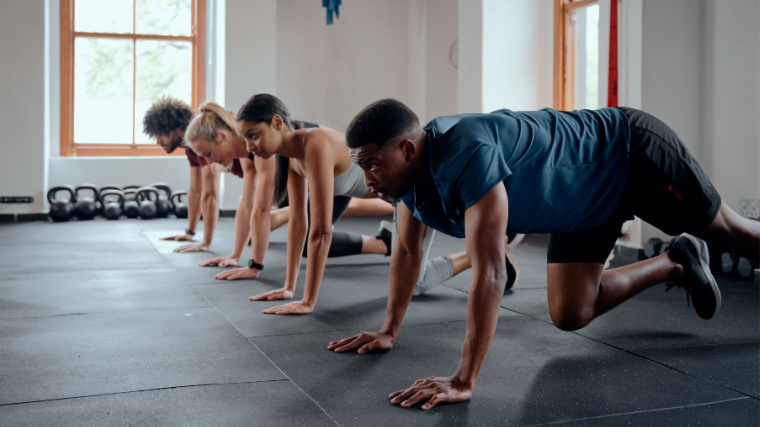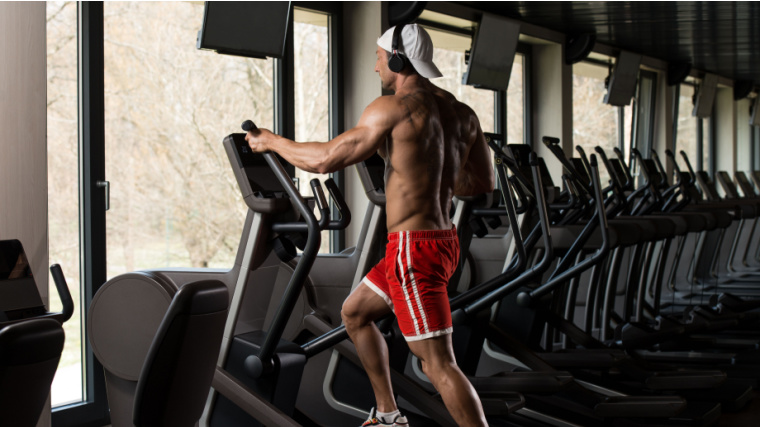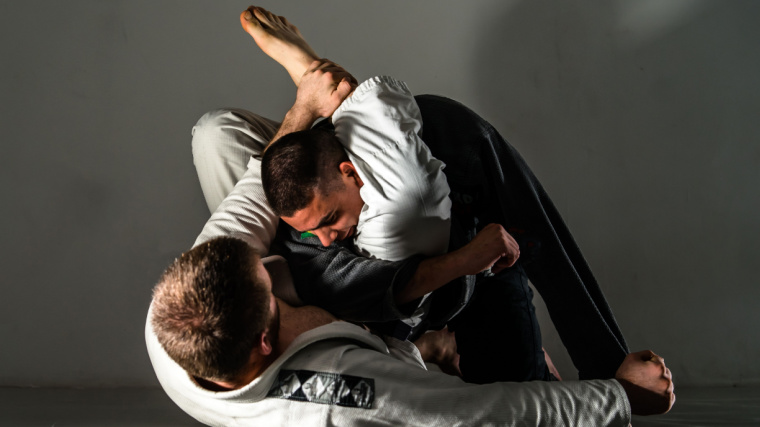Muscle Insider
New member
Unless you were homeschooled as a child, you probably have vivid — and perhaps horrific — memories of gym class. From running laps around the gymnasium floor to relay races and very poorly orchestrated games of kickball, gym class was all about cardio. It’s no wonder, then, that most folks dread cardio later in life, even if they’re...
The post What is Cardio? How to Get Started (+ Best Types of Exercise for Beginners) appeared first on BarBend.
Unless you were homeschooled as a child, you probably have vivid — and perhaps horrific — memories of gym class. From running laps around the gymnasium floor to relay races and very poorly orchestrated games of kickball, gym class was all about cardio.
It’s no wonder, then, that most folks dread cardio later in life, even if they’re gym rats dedicated to strength training. But all that huffing and puffing you did in gym class was good for more than just getting you to sit still in fifth period English.
 Credit: StratfordProductions / Shutterstock
Credit: StratfordProductions / Shutterstock
In fact, data from the scientific journal Frontiers in Cardiovascular Medicine strongly support cardiovascular exercise as a means of improving physical fitness, mental health, and many of the biomarkers associated with preventing or managing chronic disease. (1)
Here’s everything you could ever want to know about cardio — most importantly, how to get started safely and sustainably.
Editor’s Note: The content on BarBend is meant to be informative in nature, but it should not be taken as medical advice. When starting a new training regimen and/or diet, it is always a good idea to consult with a trusted medical professional. We are not a medical resource. The opinions and articles on this site are not intended for use as diagnosis, prevention, and/or treatment of health problems. They are not substitutes for consulting a qualified medical professional.
What Is Cardio?
Cardio is short for cardiovascular exercise; any form of dedicated, intentional physical activity for the express purpose of improving either your health or performance. Cardio stands distinct from other types of exercise such as weight lifting or yoga in that its primary purpose is to tax your heart and lungs rather than your skeletal muscles.
Think of it like this: All types of cardio require movement, but not all forms of movement are considered cardio. Cardio training isn’t defined by how much you sweat or how hard your heart is pounding in your chest, it is defined by intent.
 Credit: Ground Picture / Shutterstock
Credit: Ground Picture / Shutterstock
[Read More: The Best Upper Body Workouts for Strength, Muscle, Bodyweight Training, and More]
According to a position stand by the American College of Sports Medicine, (2) you can perform cardio training in short bursts of 10 minutes or less and still walk away with some health benefits. To improve things like your VO2 max or general endurance, you’ll need to push things a bit harder.
Luckily, cardio, no matter what form you enjoy, comes with a wide range of benefits. And you can nab most of them without going totally breathless.
Benefits of Cardio
The truth is, some people do their cardio out of little more than habit, whether they’re concerned about the benefits or not. However, most people engage with and perform cardiovascular exercise to improve some aspect of their health. Here’s what you stand to gain by pounding the pavement, hitting up the stair stepper, or whatever your favorite form of movement might be.
Improves Heart Health
While a set of biceps curls or bench presses primarily target your arms and chest, respectively, cardio training stimulates your heart. Your cardiovascular system, which facilitates blood flow, regulates blood pressure, shuttles nutrients around, and more, is just as trainable as your muscles are.
Research shows that regular cardiovascular exercise can help regulate your heart rate, improve blood pressure, and substantially reduce your risk of certain cardiac illnesses. (3)The best part, though, is that you can acquire many of these benefits without handcuffing yourself to the treadmill for hours upon hours every week.
[Read More: The 16 Best Pre-Workout Supplements]
Improving your cardiovascular performance takes lots of time and effort, but the general health benefits come quickly by comparison as long as you’re consistent. (2)
Helps You Lose Weight
Cardio doesn’t just help you out under the hood, though. If you perform enough of it, you can certainly change your body composition. This is because cardio, like any form of movement or exercise, burns calories.
To lose body fat, you need to be in what’s called a caloric deficit, or a negative energy balance, wherein the calories you burn exceed the calories you eat per day. Some forms of cardio burn more calories than others, depending on the intensity and duration of the session.
 Credit: Oleggg / Shutterstock
Credit: Oleggg / Shutterstock
[Read More: 5 At-Home Workouts for Strength, Muscle Growth, Power, and More]
If you’re in a caloric surplus, the elliptical or treadmill or tabata class you take won’t magically cause you to lose fat. However, as part of a robust and diverse weight loss plan, cardio can be indispensably useful.
Gets You Outdoors
Commercial gyms may be lined wall-to-wall with more treadmills than they need, but that doesn’t mean you need to carry out all your cardio training indoors. In fact, taking things outside (literally), can bolster the benefits and even add some new ones.
Plenty of research backs the idea that exercising outside is more beneficial than doing so indoors. More specifically, some studies have even alleged that exposure to nature while exercising produces a synergistic effect, where each perpetuates the value of the other. (4)
Great for Socializing
Some forms of exercise, such as bodybuilding workouts or individual sport training, can be quite isolating. This is certainly true for cardio as well, but one of the most underrated advantages of a cardiovascular exercise routine is that you can make it a social event as well.
From running clubs to spin classes to partner-based HIIT workouts, there are plenty of ways to get your blood pumping and strengthen some social bonds at the same time.
[Read More: The 12 Best Greens Powders]
What’s more, adding a social element to your exercise routine may further benefit your health. Data have shown that group-based exercise can be particularly potent as a means of alleviating mental stress and improving your motivation. (5)(6)
Types of Cardio
There’s more than one way to skin a cat, and there are definitely more types of cardio than you think. Cardio modalities differ vastly, each with their own objectives and requirements. Here’s a brief rundown — most types of cardiovascular exercise fall under these umbrellas.
Low Intensity, Steady-State
Cardiovascular exercise is generally divided into groups based upon how demanding the activity is and how fast it gets your blood pumping. Low intensity, steady-state, or LISS exercise is meant to be easy, accessible, and sustainable.
 Credit: Jasminko Ibrakovic
Credit: Jasminko Ibrakovic
/ Shutterstock
[Read More: The Best EMOM Workouts for Strength, Endurance, and Mass]
LISS cardio involves maintaining a relatively easygoing pace for a predetermined amount of time. Generally during LISS, you’ll have a heart rate between 90 and 120 beats per minute (BPM). Examples of LISS cardio include:
Note that aerobics equipment like the treadmill, elliptical, or exercise bike aren’t only used for LISS cardio. You can perform other types of cardio workouts with them, but they’re great for LISS because of the easily-adjustable difficulty levels.
Intervals
Interval training involves oscillating between periods of activity or movement and brief periods of rest. Think of a weight lifting workout, where you perform a set of reps, rest for a minute or two, and go again. That’s technically a form of interval training, but wouldn’t really count as cardio.
Most sport-specific training falls into this category. Other modalities include:
You can also do intervals on a treadmill, stair stepper, elliptical, or stationary bike. Many of these pieces of equipment even come with preset interval workouts for you to perform.
High-Intensity Interval Training
For a while (think the late 00s to mid 2010s), high-intensity interval training, or HIIT, was all the rage. HIIT was supposed to solve the game of fat loss through exercise by unlocking your fat-burning potential through bouts of highly vigorous movement that also taxed your muscles.
While this didn’t really pan out — you can’t really outsmart your own body — HIIT remains popular as challenging and time-efficient means of burning calories and improving your cardiac capacity.
 Credit: Kappri / Shutterstock
Credit: Kappri / Shutterstock
[Read More: The Best Full-Body Bodybuilding Workout for Beginner to Advanced Lifters]
HIIT stands distinct from regular interval training in that people often perform their bouts of movement by utilizing anaerobic resistance exercises, such as performing several free weight moves in a sequence before taking a break. This is sometimes called a “complex,” and is a very common type of HIIT:
You can spin up your own HIIT workout pretty easily and work with all kinds of different equipment. The key feature of HIIT cardio is, well, the high training intensities between rest periods.
A good HIIT workout will also ask you to do a bit more than run, jog, or swim laps. Research shows that HIIT is particularly effective at training different bodily systems at once, making it a great way to get active if you have a hectic schedule. (7)
How To Add Cardio to Your Routine
Adding cardio to your routine is easy — if you have a routine established already. While cardiovascular exercise doesn’t tax your body in the same way as resistance training, it still demands energy and induces fatigue.
If you have a workout program in place already, you should be tactical about injecting additional cardio. Start conservatively. Aim for 1 to 3 short bouts either on your off days as a form of active recovery, or following your resistance training or sport-specific workouts.
How Long Should a Cardio Workout Last?
Remember, if you’re performing cardio for health purposes, you don’t need to spend hours on the track every week. In fact, a 10-minute bout of cardiovascular exercise may confer a majority of the health-related benefits you’re after. (2)
[Read More: The 15 Best Home Gym Machines]
Beyond that, you’re looking at performance-related factors. If you want to improve your cardiovascular endurance, you’ll have to run, jog, walk, hike, swim, or bike for longer durations over time. It’s possible for cardio workouts to last upwards, or over, an hour.
How Often Should You Do Cardio?
Extra cardio adds to your total volume of exercise. And, while it is possible to see health benefits from cardio with very low “doses”, some data show that certain folks will need more exercise than others, or to exercise with more vigor, in order to see improvements. (8)
How To Start Cardio
Most forms of cardiovascular exercise are pretty much grab-and-go. If you want to walk for cardio, all you need are space and time. Want to get your heart pumping with some Brazilian jiu-jitsu?
 Credit: Miljan Zivkovic / Shutterstock
Credit: Miljan Zivkovic / Shutterstock
[Read More: The 16 Best Creatine Supplements]
There’s a bit more buy-in. Generally speaking, though, no matter what type of cardio you prefer, you should bring the following with you:
How Cardio Helps With Weight Loss
Cardiovascular exercise is a useful piece of the weight loss puzzle, but make no mistake, cardio has no magical quality that makes it better for losing fat than any other form of physical activity.
The value of an exercise modality with respect to weight change depends on how many calories you burn during the session. If you burn more calories, you would theoretically lose more weight (provided your diet is in check and you’re in a caloric deficit).
So, on the surface, a very intense bout of HIIT would be better for weight loss than 20 minutes of low-intensity walking on the treadmill. However, you need to consider other factors such as sustainability and enjoyment as well. It may be easier to stick to a few sessions of walking and, ultimately, burn more calories long-term.
FAQs
Here are some additional common questions about cardio that you might have.
Is cardio good for weight loss?[/b] Cardio is good for burning calories, and a caloric deficit (when you expend more than you ingest) is what creates weight loss. So, you can certainly use cardio to increase your physical activity, which will contribute to weight loss. But cardio doesn’t meaningfully change your body on its own.
What are the benefits of cardio?[/b] Cardio is fantastic for improving the functionality and health of your heart, as well as relieving stress and improving mental health.
What are examples of cardio?[/b] You can do just about anything for cardio. Popular choices include walking, running, cycling, swimming, or taking a group exercise class.
How does cardio help the brain?[/b] Cardio is a fantastic way to regulate your mood and reduce stress. Plenty of studies show that regular exercise can meaningfully improve your mental health.
References
[*]Nystoriak MA, Bhatnagar A. Cardiovascular Effects and Benefits of Exercise. Front Cardiovasc Med. 2018 Sep 28;5:135. doi: 10.3389/fcvm.2018.00135. PMID: 30324108; PMCID: PMC6172294.
[*]American College of Sports Medicine Position Stand. The recommended quantity and quality of exercise for developing and maintaining cardiorespiratory and muscular fitness, and flexibility in healthy adults. (1998). Medicine and science in sports and exercise, 30(6), 975–991.
[*]Paluch, A. E., Bajpai, S., Bassett, D. R., Carnethon, M. R., Ekelund, U., Evenson, K. R., Galuska, D. A., Jefferis, B. J., Kraus, W. E., Lee, I. M., Matthews, C. E., Omura, J. D., Patel, A. V., Pieper, C. F., Rees-Punia, E., Dallmeier, D., Klenk, J., Whincup, P. H., Dooley, E. E., Pettee Gabriel, K., … Steps for Health Collaborative (2022). Daily steps and all-cause mortality: a meta-analysis of 15 international cohorts. The Lancet. Public health, 7(3), e219–e228.
[*]Gladwell VF, Brown DK, Wood C, Sandercock GR, Barton JL. The great outdoors: how a green exercise environment can benefit all. Extrem Physiol Med. 2013 Jan 3;2(1):3. doi: 10.1186/2046-7648-2-3. PMID: 23849478; PMCID: PMC3710158.
[*]Plante, Thomas & Coscarelli, Laura & Ford, Máire. (2001). Does Exercising with Another Enhance the Stress-Reducing Benefits of Exercise?. International Journal of Stress Management. 8. 201-213. 10.1023/A:1011339025532.
[*]Hanson, S., & Jones, A. (2015). Is there evidence that walking groups have health benefits? A systematic review and meta-analysis. British journal of sports medicine, 49(11), 710–715.
[*]Ito S. High-intensity interval training for health benefits and care of cardiac diseases – The key to an efficient exercise protocol. World J Cardiol. 2019 Jul 26;11(7):171-188. doi: 10.4330/wjc.v11.i7.171. PMID: 31565193; PMCID: PMC6763680.
[*]Ross, R., de Lannoy, L., & Stotz, P. J. (2015). Separate Effects of Intensity and Amount of Exercise on Interindividual Cardiorespiratory Fitness Response. Mayo Clinic proceedings, 90(11), 1506–1514.
Featured Image: StratfordProductions / Shutterstock
The post What is Cardio? How to Get Started (+ Best Types of Exercise for Beginners) appeared first on BarBend.
Click here to view the article.
The post What is Cardio? How to Get Started (+ Best Types of Exercise for Beginners) appeared first on BarBend.
Unless you were homeschooled as a child, you probably have vivid — and perhaps horrific — memories of gym class. From running laps around the gymnasium floor to relay races and very poorly orchestrated games of kickball, gym class was all about cardio.
It’s no wonder, then, that most folks dread cardio later in life, even if they’re gym rats dedicated to strength training. But all that huffing and puffing you did in gym class was good for more than just getting you to sit still in fifth period English.

In fact, data from the scientific journal Frontiers in Cardiovascular Medicine strongly support cardiovascular exercise as a means of improving physical fitness, mental health, and many of the biomarkers associated with preventing or managing chronic disease. (1)
Here’s everything you could ever want to know about cardio — most importantly, how to get started safely and sustainably.
Editor’s Note: The content on BarBend is meant to be informative in nature, but it should not be taken as medical advice. When starting a new training regimen and/or diet, it is always a good idea to consult with a trusted medical professional. We are not a medical resource. The opinions and articles on this site are not intended for use as diagnosis, prevention, and/or treatment of health problems. They are not substitutes for consulting a qualified medical professional.
- What Is Cardio?
- Benefits of Cardio
- Types of Cardio
- How To Add Cardio to Your Routine
- How Cardio Helps With Weight Loss
What Is Cardio?
Cardio is short for cardiovascular exercise; any form of dedicated, intentional physical activity for the express purpose of improving either your health or performance. Cardio stands distinct from other types of exercise such as weight lifting or yoga in that its primary purpose is to tax your heart and lungs rather than your skeletal muscles.
Think of it like this: All types of cardio require movement, but not all forms of movement are considered cardio. Cardio training isn’t defined by how much you sweat or how hard your heart is pounding in your chest, it is defined by intent.

[Read More: The Best Upper Body Workouts for Strength, Muscle, Bodyweight Training, and More]
According to a position stand by the American College of Sports Medicine, (2) you can perform cardio training in short bursts of 10 minutes or less and still walk away with some health benefits. To improve things like your VO2 max or general endurance, you’ll need to push things a bit harder.
Luckily, cardio, no matter what form you enjoy, comes with a wide range of benefits. And you can nab most of them without going totally breathless.
Benefits of Cardio
The truth is, some people do their cardio out of little more than habit, whether they’re concerned about the benefits or not. However, most people engage with and perform cardiovascular exercise to improve some aspect of their health. Here’s what you stand to gain by pounding the pavement, hitting up the stair stepper, or whatever your favorite form of movement might be.
Improves Heart Health
While a set of biceps curls or bench presses primarily target your arms and chest, respectively, cardio training stimulates your heart. Your cardiovascular system, which facilitates blood flow, regulates blood pressure, shuttles nutrients around, and more, is just as trainable as your muscles are.
Research shows that regular cardiovascular exercise can help regulate your heart rate, improve blood pressure, and substantially reduce your risk of certain cardiac illnesses. (3)The best part, though, is that you can acquire many of these benefits without handcuffing yourself to the treadmill for hours upon hours every week.
[Read More: The 16 Best Pre-Workout Supplements]
Improving your cardiovascular performance takes lots of time and effort, but the general health benefits come quickly by comparison as long as you’re consistent. (2)
Helps You Lose Weight
Cardio doesn’t just help you out under the hood, though. If you perform enough of it, you can certainly change your body composition. This is because cardio, like any form of movement or exercise, burns calories.
To lose body fat, you need to be in what’s called a caloric deficit, or a negative energy balance, wherein the calories you burn exceed the calories you eat per day. Some forms of cardio burn more calories than others, depending on the intensity and duration of the session.

[Read More: 5 At-Home Workouts for Strength, Muscle Growth, Power, and More]
If you’re in a caloric surplus, the elliptical or treadmill or tabata class you take won’t magically cause you to lose fat. However, as part of a robust and diverse weight loss plan, cardio can be indispensably useful.
Gets You Outdoors
Commercial gyms may be lined wall-to-wall with more treadmills than they need, but that doesn’t mean you need to carry out all your cardio training indoors. In fact, taking things outside (literally), can bolster the benefits and even add some new ones.
Plenty of research backs the idea that exercising outside is more beneficial than doing so indoors. More specifically, some studies have even alleged that exposure to nature while exercising produces a synergistic effect, where each perpetuates the value of the other. (4)
Great for Socializing
Some forms of exercise, such as bodybuilding workouts or individual sport training, can be quite isolating. This is certainly true for cardio as well, but one of the most underrated advantages of a cardiovascular exercise routine is that you can make it a social event as well.
From running clubs to spin classes to partner-based HIIT workouts, there are plenty of ways to get your blood pumping and strengthen some social bonds at the same time.
[Read More: The 12 Best Greens Powders]
What’s more, adding a social element to your exercise routine may further benefit your health. Data have shown that group-based exercise can be particularly potent as a means of alleviating mental stress and improving your motivation. (5)(6)
Types of Cardio
There’s more than one way to skin a cat, and there are definitely more types of cardio than you think. Cardio modalities differ vastly, each with their own objectives and requirements. Here’s a brief rundown — most types of cardiovascular exercise fall under these umbrellas.
Low Intensity, Steady-State
Cardiovascular exercise is generally divided into groups based upon how demanding the activity is and how fast it gets your blood pumping. Low intensity, steady-state, or LISS exercise is meant to be easy, accessible, and sustainable.

/ Shutterstock
[Read More: The Best EMOM Workouts for Strength, Endurance, and Mass]
LISS cardio involves maintaining a relatively easygoing pace for a predetermined amount of time. Generally during LISS, you’ll have a heart rate between 90 and 120 beats per minute (BPM). Examples of LISS cardio include:
- Walking
- House chores or gardening
- Casual swimming
- Elliptical
- Stair-climber
Note that aerobics equipment like the treadmill, elliptical, or exercise bike aren’t only used for LISS cardio. You can perform other types of cardio workouts with them, but they’re great for LISS because of the easily-adjustable difficulty levels.
Intervals
Interval training involves oscillating between periods of activity or movement and brief periods of rest. Think of a weight lifting workout, where you perform a set of reps, rest for a minute or two, and go again. That’s technically a form of interval training, but wouldn’t really count as cardio.
Most sport-specific training falls into this category. Other modalities include:
You can also do intervals on a treadmill, stair stepper, elliptical, or stationary bike. Many of these pieces of equipment even come with preset interval workouts for you to perform.
High-Intensity Interval Training
For a while (think the late 00s to mid 2010s), high-intensity interval training, or HIIT, was all the rage. HIIT was supposed to solve the game of fat loss through exercise by unlocking your fat-burning potential through bouts of highly vigorous movement that also taxed your muscles.
While this didn’t really pan out — you can’t really outsmart your own body — HIIT remains popular as challenging and time-efficient means of burning calories and improving your cardiac capacity.

[Read More: The Best Full-Body Bodybuilding Workout for Beginner to Advanced Lifters]
HIIT stands distinct from regular interval training in that people often perform their bouts of movement by utilizing anaerobic resistance exercises, such as performing several free weight moves in a sequence before taking a break. This is sometimes called a “complex,” and is a very common type of HIIT:
You can spin up your own HIIT workout pretty easily and work with all kinds of different equipment. The key feature of HIIT cardio is, well, the high training intensities between rest periods.
A good HIIT workout will also ask you to do a bit more than run, jog, or swim laps. Research shows that HIIT is particularly effective at training different bodily systems at once, making it a great way to get active if you have a hectic schedule. (7)
How To Add Cardio to Your Routine
Adding cardio to your routine is easy — if you have a routine established already. While cardiovascular exercise doesn’t tax your body in the same way as resistance training, it still demands energy and induces fatigue.
If you have a workout program in place already, you should be tactical about injecting additional cardio. Start conservatively. Aim for 1 to 3 short bouts either on your off days as a form of active recovery, or following your resistance training or sport-specific workouts.
How Long Should a Cardio Workout Last?
Remember, if you’re performing cardio for health purposes, you don’t need to spend hours on the track every week. In fact, a 10-minute bout of cardiovascular exercise may confer a majority of the health-related benefits you’re after. (2)
[Read More: The 15 Best Home Gym Machines]
Beyond that, you’re looking at performance-related factors. If you want to improve your cardiovascular endurance, you’ll have to run, jog, walk, hike, swim, or bike for longer durations over time. It’s possible for cardio workouts to last upwards, or over, an hour.
How Often Should You Do Cardio?
Extra cardio adds to your total volume of exercise. And, while it is possible to see health benefits from cardio with very low “doses”, some data show that certain folks will need more exercise than others, or to exercise with more vigor, in order to see improvements. (8)
How To Start Cardio
Most forms of cardiovascular exercise are pretty much grab-and-go. If you want to walk for cardio, all you need are space and time. Want to get your heart pumping with some Brazilian jiu-jitsu?

[Read More: The 16 Best Creatine Supplements]
There’s a bit more buy-in. Generally speaking, though, no matter what type of cardio you prefer, you should bring the following with you:
- Appropriate footwear
- A water bottle or flask for hydration
- Light, breathable, sweat-wicking clothing
- Music or entertainment (think podcast or virtual trainer)
How Cardio Helps With Weight Loss
Cardiovascular exercise is a useful piece of the weight loss puzzle, but make no mistake, cardio has no magical quality that makes it better for losing fat than any other form of physical activity.
The value of an exercise modality with respect to weight change depends on how many calories you burn during the session. If you burn more calories, you would theoretically lose more weight (provided your diet is in check and you’re in a caloric deficit).
So, on the surface, a very intense bout of HIIT would be better for weight loss than 20 minutes of low-intensity walking on the treadmill. However, you need to consider other factors such as sustainability and enjoyment as well. It may be easier to stick to a few sessions of walking and, ultimately, burn more calories long-term.
FAQs
Here are some additional common questions about cardio that you might have.
Is cardio good for weight loss?[/b] Cardio is good for burning calories, and a caloric deficit (when you expend more than you ingest) is what creates weight loss. So, you can certainly use cardio to increase your physical activity, which will contribute to weight loss. But cardio doesn’t meaningfully change your body on its own.
What are the benefits of cardio?[/b] Cardio is fantastic for improving the functionality and health of your heart, as well as relieving stress and improving mental health.
What are examples of cardio?[/b] You can do just about anything for cardio. Popular choices include walking, running, cycling, swimming, or taking a group exercise class.
How does cardio help the brain?[/b] Cardio is a fantastic way to regulate your mood and reduce stress. Plenty of studies show that regular exercise can meaningfully improve your mental health.
References
[*]Nystoriak MA, Bhatnagar A. Cardiovascular Effects and Benefits of Exercise. Front Cardiovasc Med. 2018 Sep 28;5:135. doi: 10.3389/fcvm.2018.00135. PMID: 30324108; PMCID: PMC6172294.
[*]American College of Sports Medicine Position Stand. The recommended quantity and quality of exercise for developing and maintaining cardiorespiratory and muscular fitness, and flexibility in healthy adults. (1998). Medicine and science in sports and exercise, 30(6), 975–991.
[*]Paluch, A. E., Bajpai, S., Bassett, D. R., Carnethon, M. R., Ekelund, U., Evenson, K. R., Galuska, D. A., Jefferis, B. J., Kraus, W. E., Lee, I. M., Matthews, C. E., Omura, J. D., Patel, A. V., Pieper, C. F., Rees-Punia, E., Dallmeier, D., Klenk, J., Whincup, P. H., Dooley, E. E., Pettee Gabriel, K., … Steps for Health Collaborative (2022). Daily steps and all-cause mortality: a meta-analysis of 15 international cohorts. The Lancet. Public health, 7(3), e219–e228.
[*]Gladwell VF, Brown DK, Wood C, Sandercock GR, Barton JL. The great outdoors: how a green exercise environment can benefit all. Extrem Physiol Med. 2013 Jan 3;2(1):3. doi: 10.1186/2046-7648-2-3. PMID: 23849478; PMCID: PMC3710158.
[*]Plante, Thomas & Coscarelli, Laura & Ford, Máire. (2001). Does Exercising with Another Enhance the Stress-Reducing Benefits of Exercise?. International Journal of Stress Management. 8. 201-213. 10.1023/A:1011339025532.
[*]Hanson, S., & Jones, A. (2015). Is there evidence that walking groups have health benefits? A systematic review and meta-analysis. British journal of sports medicine, 49(11), 710–715.
[*]Ito S. High-intensity interval training for health benefits and care of cardiac diseases – The key to an efficient exercise protocol. World J Cardiol. 2019 Jul 26;11(7):171-188. doi: 10.4330/wjc.v11.i7.171. PMID: 31565193; PMCID: PMC6763680.
[*]Ross, R., de Lannoy, L., & Stotz, P. J. (2015). Separate Effects of Intensity and Amount of Exercise on Interindividual Cardiorespiratory Fitness Response. Mayo Clinic proceedings, 90(11), 1506–1514.
Featured Image: StratfordProductions / Shutterstock
The post What is Cardio? How to Get Started (+ Best Types of Exercise for Beginners) appeared first on BarBend.
Click here to view the article.








